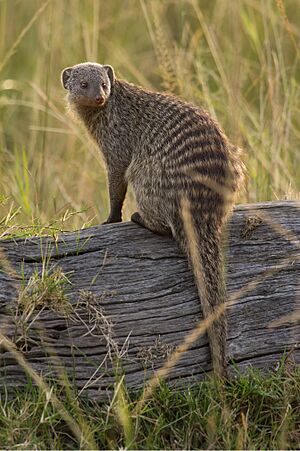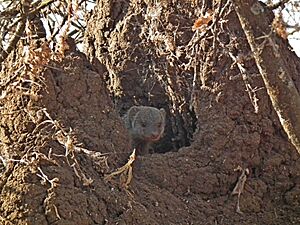Banded mongoose facts for kids
Quick facts for kids Banded mongoose |
|
|---|---|
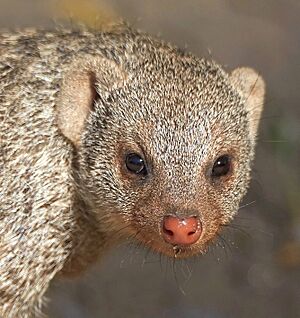 |
|
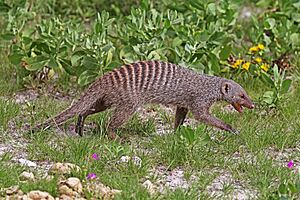 |
|
| Banded mongooses (M. m. grisonax) at Etosha National Park, northern Namibia | |
| Conservation status | |
| Scientific classification | |
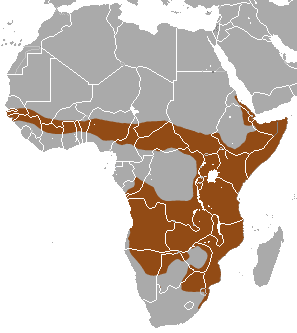 |
|
| range of the banded mongoose |
The banded mongoose (Mungos mungo) is a cool animal found across Africa. It lives in places like savannas, open forests, and grasslands. These mongooses mostly eat beetles and millipedes.
Unlike most other mongoose species, banded mongooses live in large groups. They have a special way of living together in their colonies. They often use termite mounds as their homes.
Contents
About Banded Mongooses
The banded mongoose is a strong animal. It has a big head, small ears, and short, powerful legs. Its tail is long, almost as long as its body!
Their fur is usually grayish-brown and black. You can spot them by the dark stripes across their back. Their legs and snout are darker, while their belly is lighter.
Banded mongooses have long, strong claws. These claws are perfect for digging in the ground. Their nose can be gray-brown or even orange-red.
An adult banded mongoose can grow to be about 30 to 45 cm long. They usually weigh between 1.5 and 2.25 kg. Their tail adds another 15 to 30 cm to their length.
Where Banded Mongooses Live
Banded mongooses live in many parts of Africa. You can find them in East, Southeast, and South-Central Africa. They also live in the northern savannas of West Africa.
These animals prefer savannas, open forests, and grasslands. They like to be near water, but can also live in dry, thorny bushland. However, they do not live in deserts.
They use different types of dens for shelter. Termite mounds are their favorite homes. They also use rock shelters, thick bushes, and holes under bushes.
Mongooses like termite mounds that have many entrances. This helps more group members get in and out easily. It also helps with air flow.
Farms have actually helped banded mongooses! The crops grown on farms give them extra food. This has helped their numbers grow.
Many banded mongooses live in Africa's protected areas. For example, in the Serengeti in Tanzania, there are about three mongooses per square kilometer.
Life in a Mongoose Group
Banded mongooses live in groups of 7 to 40 individuals. On average, a group has about 20 mongooses. At night, they all sleep together in underground dens. They often use old termite mounds.
They move to a new den every 2 or 3 days. If they are in danger from predators like African wild dogs, they huddle together. They lie on top of each other with their heads facing outwards to protect themselves.
There isn't usually a strict boss in mongoose groups. They don't fight much over food. Usually, the one who finds the food first gets to eat it.
Sometimes, males might fight when females are ready to have babies. Older females are usually in charge. They tend to have babies earlier and have more of them.
If a group gets too big, some females might be forced to leave. These females might then start new groups with other males.
Groups of mongooses are very aggressive towards each other. Fights between groups can even cause injuries or deaths. But sometimes, females will mate with males from a rival group during these fights!
Mongooses mark their territories with scent. This helps them communicate with their own group members. Within a group, they compete for mates. Between groups, they compete for food and resources.
What Banded Mongooses Eat
Banded mongooses mainly eat insects, centipedes, small reptiles, and birds. Millipedes and beetles are a big part of their diet. They also eat ants, crickets, termites, grasshoppers, and snails.
Sometimes, they will eat mice, rats, frogs, lizards, small snakes, and bird eggs. They also eat wild fruits. If it's very dry, they might drink water from puddles or lake shores.
Mongooses look for food together in groups. But each mongoose searches for its own meal. However, they work as a team if they face dangerous snakes like cobras.
They usually look for food in the morning for a few hours. Then they rest in the shade. They often go foraging again in the late afternoon.
They use their strong sense of smell to find prey. Then they dig them out with their long claws. They dig in holes in the ground and even in trees. Mongooses also like to search near animal dung, because it attracts beetles.
They make low grunting sounds every few seconds to talk to each other. If they catch prey that has toxins, they roll it on the ground to remove the toxins. If the prey is hard, they throw it against hard surfaces to break it open.
Mongoose Babies
Unlike many other social mongoose species, all females in a banded mongoose group can have babies. They all get ready to breed about 10 days after giving birth.
One to three dominant males will guard and mate with the females. These males watch the females closely and chase away other males. While these dominant males do most of the mating, females sometimes try to sneak away to mate with other males in the group.
A guarding male will stay with a female for 2 or 3 days. He will snap or lunge at any other males that come too close. Other males might follow them, hoping for a chance to mate secretly.
Pregnancy lasts about 60 to 70 days. Most females in a group give birth around the same time. They usually have between two and six pups, with four being the average.
For the first four weeks, the pups stay in the dens. They are looked after by a single helper, called an "escort." These helpers are often young males or females who have also had babies in the group. They help make sure the pups get enough food.
While the other mongooses go out to find food, these helpers guard the pups. After four weeks, the pups are big enough to go foraging themselves. Each pup still has an adult "escort" who helps it find food and keeps it safe.
Mongoose Friends
Banded mongooses have been seen helping warthogs in Kenya and Uganda. They remove ticks, fleas, and other parasites from the warthogs!
Images for kids
-
Banded mongoose skeleton in the Museum of Osteology



